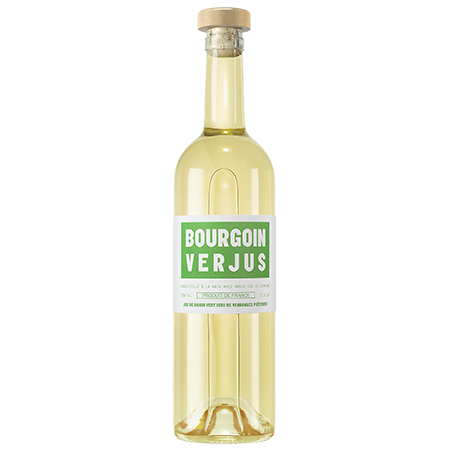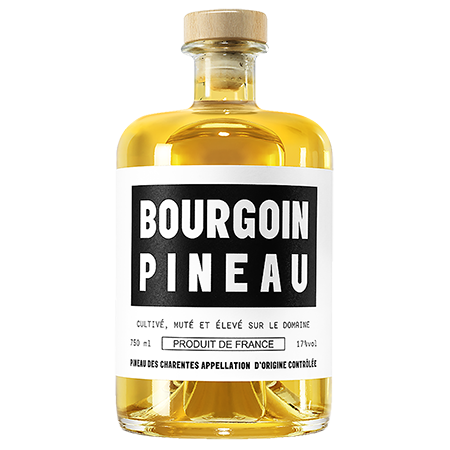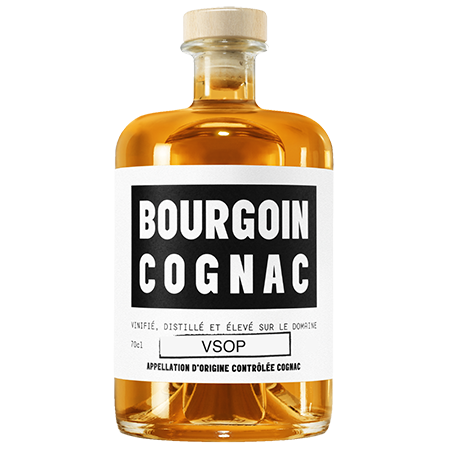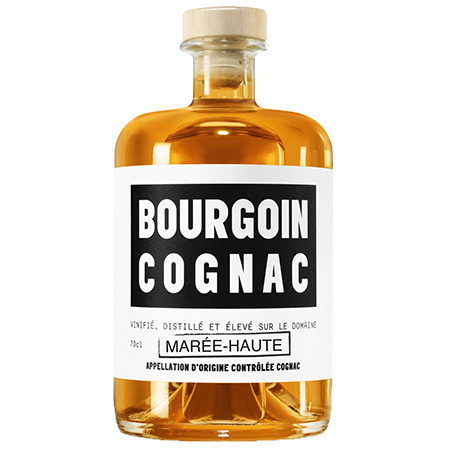Bourgoin Cognac
Epitomizing the true spirit of a micro-artisan Cognac house, Bourgoin is all about a true passion for their land and vines, through an honest, transparent distillation of their terroir.
It has to be said, when examining the emerging movement of natural, agricultural spirits producers, the Cognac region is not always the first place that comes to mind; that is, until one encounters work of the outstanding, iconoclastic Bourgoin house. The family estate is currently led by Frédéric Bourgoin, the fourth generation of a family of grape growers and Cognac distillers from the village of Tarsac in Fins Bois, approximately 30 kilometers east of the town of Cognac. While Frédéric and his wife Rebecca are the current visionaries behind their label, their entire extended family lives on the estate, where they have farmed their estate vineyards organically since 1986. Frédéric and Rebecca represent a very different approach in this negociant-dominated region, revitalizing the spirit with their energetic, romantic vision of Cognac.
Frédéric is the first generation of his family to estate-bottle, bringing their authentic, viticultural Cognac to a wider audience; including a laundry list of the finest European Michelin-starred restaurants. His philosophy strictly adheres to the principles and methods handed down by his parents, grandparents, and great-grandparents. Bourgoin applies a modern attitude and savoir faire to time-tested, traditional methods – a refreshingly transparent and straightforward approach in one of France’s most opaque and commercial regions.
The exceptional quality of Bourgoin Cognac begins in their estate vineyards. When Frédéric’s great grandparents, Leon Marcel and Odette married, they merged their families’ vineyards, beginning the Bourgoin legacy. From each generation, the family has slowly acquired a small number of vineyards. These vineyards are scattered throughout a few different villages in the appellation of Fins Bois, planted on some of the highest quality soils in the Cognac region. While Fins Bois is primarily known for clay-and-limestone-based soils from the Jurassic period, it is no secret to those in the know that the region also contains vineyards planted on plots of textbook Cretaceous-period chalk (just like those in Grande Champagne), scattered throughout the large appellation. There is incredible diversity in the soils of Fins Bois, which defies the over-simplified way vineyards are often classified. This is as true in Cognac as it is in any other viticultural region of the world: generalizations are often blunt instruments that ignore the finer details of the complexities of geology.
This concept is essential to understanding the work of Bourgoin.
On the way to Bourgoin, one passes vineyards nearest to their house, which are delineated by the Bourgoin Monolith, a large, imposing block of solid chalk pulled from the ground nearby. Erected in August 2019, the Bourgoin monolith weighs 2.7 tons and consists of calcium carbonate, dating from the Middle Cenomanian (Cretaceous) period. This monolith is both an identification marker for the Bourgoin vineyard and an educational tool. It reflects the nearly 54 meters of chalk found beneath their vineyards, which lends the exceptional acidity and finesse to their eaux-de-vie found only in the very best Cognacs. The quality of Bourgoin’s soil transcends not only their classification, but also the financial system instilled by the large conglomerates and negociants, a system that is strictly incentivized by maintaining the status quo.
The Bourgoin family have been working their vineyards organically since 1986, and are currently in the process of attaining their organic certification. Their vineyards are planted exclusively to double Guyot-pruned ugni blanc, the most typical variety in the Cognac appellation. Alcoholic fermentation takes place in temperature-controlled outdoor vats and while the estate typically uses indigenous yeast for spontaneous fermentation, they occasionally use local yeast, lab-multiplied in difficult years. They never use commercial yeast. The base wine is fermented for four days with temperature control and without malolactic fermentation, which preserves the acidity essential to well structured Cognac. Preventing malolactic fermentation without added sulfites is difficult, and is only possible due to the speed at which they can distill the harvest. Malolactic fermentation is controlled by skill and experience, rather than additives.
Working in this spirit, Bourgoin Cognac takes a craftsman approach in producing a transparent, natural spirit, carefully considering and guiding each step of the process as gently as possible. One of the many contradictions of the Cognac region is that while it employs detailed controls for both viticulturists and winemakers, it places very few restrictions on wholesalers. This means that while the base wine is incredibly natural: without acidification, sulfites, or chaptalization, it is in the warehouse that the spirit is often steered away from the purity obtained in the vineyard. With 98% of base Cognac currently being sold to warehouses, rather than bottled by grower-producers, control over the spirit from vineyard to bottle is exceedingly rare.
Another important element in the quality of Bourgoin is their distillery. The Bourgoin family’s original still is a three-hectoliter copper Charentais still from 1903, fired by a small wood furnace from the 1800s. Their antique still’s mechanics are so simple that during the distillation months, Frédéric’s great-grandfather Leon Bourgoin (the first to plant the family vineyards) would adhere a little copper cup onto the swan neck with wax before he went to sleep. When the neck was warm enough to indicate the evaporation of alcohol vapors, the wax would melt and drop the cup to the ground and precise a loud sound, waking and alerting him that distillation had begun.
In the 1970s, Frédéric’s grandfather Michel Bourgoin began to modernize their distillation.
He bought a 20 hectoliter Pruhlo still, a name also found in Martinique, as well as a state-of-the-art automation panel that allowed him to control the heat of the still, improving the consistency of the spirit. Michel passed this still down to Frédéric’s father Alain, who, in addition to expanding their cellar, contributed his own distillation innovation. Alain was the first to pioneer Bourgoin’s revolutionary double-lees distillation, leading to one of their signature house styles. Lees are leftover yeast particles from autolysis, which is the self-destruction of yeast cells by enzymes created from fermentation. Double-lees distillation began as an accident, which occurred when Alain pumped a second batch of lees into an already full tank.
Bourgoin Cognac is distilled with double the lees usually contained in base wine destined for Cognac production. This process allows for the additional extraction of esters to create a Cognac with incomparable aromatic intensity. With an impressive 200mg of esters per liter, the Bourgoin’s Double Lies Cognac contains three times more of these flavor components than those found in a standard Cognac. The resulting batch of Cognac had an increased complexity and an enchanting texture. The double lees technique became a trademark of the Bourgoin house style, providing a contrast to houses distilling either with partial lees, or without lees.
Alain Bourgoin also made a substantial contribution to the house in the development of their barrel program. While Bourgoin has barrels dating back to their great grandparents in the 1960s, Alain made a significant contribution, gradually increasing their cellar stock. In practice, Bourgoin incorporates new casks very carefully, washing them at least three times with fresh eau de vie prior to their use for cask-aging. They work with a handful of coopers to source their 350L barrels from the Limousin forest. With regards to oak barrels, Frédéric points out that the soil beneath the tree is actually a more significant factor than the tree variety. While he selects for a wider-grain wood, simply sourcing pedunculate oak (the type traditionally prized in Cognac for its wider-grain) is no longer enough. As the oak trees in the Limousin forest have begun to crossbreed, the soils have become a decisive factor for the quality of wood a tree will produce. This exemplifies the evolution of much of the old wisdom of Cognac, and how producers like Frédéric and Rebecca are revolutionizing this historic region.
Finally, in 2012, it was Frédéric’s turn to take the helm of the family business. Building on the work of previous generations, he was the first to bottle and sell Bourgoin Cognac under the family name. He also created the now-iconic label, which places transparency of process at the center of the design, delivering complete production details, going so far as to include Frédéric’s cell phone number in case the drinker has any questions! His mission is to capture and share the pure, authentic Cognac that the family has been producing for decades. His commitment to these values is absolute, as Bourgoin uses zero additives beyond local spring water — no sugar, no caramel coloring, no boisé — in stark contrast to the AOC’s allowed 16g per liter of additives. While much of the argument for these additives is to preserve yearly consistency, Bourgoin Cognac is proudly agricultural in nature, telling a story of the land and the cellar that define the house. The tracking of their vineyard production is so detailed that each bottle carries on it GPS coordinates for the exact vineyard that Cognac originated in.
Even the water source used for downproofing their Cognacs is carefully considered and hyper-local. Bourgoin exclusively uses Fontaine Jolival, which owes its name to an ancient artesian well entombed 162 meters underground in an impermeable Portlandian aquifer, in the heart of the Charraud valley, a few kilometers south of Angoulême, in the Fins Bois cru of the AOC Cognac. Fontaine Jolival develops its purity and lightness via natural filtration carried out through the various layers of rock for more than 20,000 years. Through its long, undisturbed journey in the aquifer, Fontaine Jolival water has acquired its unique signature of trace minerals and exceptional purity, being completely free of all pollution linked to human activity, including nitrates, pesticides, and other chemicals.
This commitment to authenticity and transparency invariably leads to some variation from bottle to bottle, or year to year, which though it is uncommon in Cognac, is familiar to drinkers of many agricultural spirits like agricole-style rhum or mezcal. Bourgoin Cognac’s resistance to blending is a style in and of itself, and a defining quality of their decidedly viticultural Cognac.
In the continued growth of the family’s Cognac heritage, Frédéric manages to strike a perfect balance between innovation and history. Much like his father before him with his double lees distillation, Frédéric continues to push the boundaries while remaining an entirely natural spirit. In their eau-de-mer “Marée Haute”, for example, the XO Cognac inside is downproofed with up to 1% micro-filtered seawater — the first Cognac of its kind. This additional salt content opens up the flavors of the Cognac, giving it a lively expressiveness that is unique, even among natural Cognacs.
Bourgoins distinctiveness does not end with Cognac. Their Pineau des Charentes, a signature mistelle of the region, is playfully described by Frédéric as “75% grape juice, 25% Cognac, and 100% pleasure.” Uniquely, this pineau undergoes oxidative aging for 12 months in partially filled ex-Cognac barrels. The Pineau is then moved into stainless steel tanks outdoors where it ages for nine years before bottling unfined, unfiltered. Not only does this process convert the aperitif’s typical fructose into glucose, preventing its sweetness from coming across as overly sugary, but it allows the pineau to remain remarkably stable once opened. Bourgoin even produces a notably delicious verjus, carefully made with the exact same pH as citrus juice — a sustainable and flavorful source of acidity both for cooking and for cocktails.
Frédéric does not believe that all this innovation flies in the face of the way his ancestors made Cognac before him. Instead, his “Cognac revolution” is a return to Bourgoin’s roots:
“The word revolution does not mean the sudden appearance of something new and unprecedented. Rather, it indicates the idea of a return, like that of our planet when it completes its orbit around the sun. The revolution is a return to the sources of what is ancient, pure and fundamental. It is a journey to rediscover and restore first principles. It’s about restoring what was supposed to be as it was originally.”
This is a long overdue “revolution.” Due to the warehouser / negociant system which dominates the region, a slow slide to complete financial inequity has developed to an even greater extent than in most other winemaking or distilling regions. The incredibly strict regulations on the viticulturists, paired with the relatively low prices for their grapes or distillate, have slowly drained financial resources from the families in the Cognac villages into the bank accounts of Paris-based multinationals. The city of Cognac itself is nearly a ghost town, dominated by large, well-manicured visitor centers and boarded-up, once-grand storefronts. Sadly, the current scale of the region does not leave much room for human-scale commerce. It is important to understand these harsh realities as a backdrop for the context of radicals like Bourgoin.
Frédéric’s vision is bigger still than Cognac.
Bourgoin was one of the first signatories of the Gnôle Naturelle Manifesto (Natural Booze), a growing movement of European distillers and sympathizers working towards the revitalization of natural, unadulterated spirits. Rather than simply being a trend or a brand of “naturalness,” they have 12 strict tenets for what constitutes a Gnôle Naturelle, including: no purchased ethyl alcohol, no additives or interventions, strictly organic (practicing or certified) base materials, and no filtration.
“In light of a rising craft fashion and with the EU-organic label becoming more and more delusional,” their manifesto states, “we, ‘natural distillers,’ feel the need to explain what we do and what distinguishes us from those who work industrially, and many other ‘artisans.”
As this collective continues to grow in influence, groups such as RAW Wine, for example, are revising guidelines for spirits entries to align more closely with the Gnôle Naturelle tenets. The spirits community has a long way to go before the idea of a minimal-intervention spirit becomes mainstream, or even well understood, but the movement has begun — with Bourgoin Cognac on the forefront of this evolution.
The Bourgoin family is serious about their Cognac, but they also see their spirits as a labor of love and joy as the primary tenet of life. This is evident in Rebecca Bourgoin’s self-designated title of ‘Happiness Manager’ at Bourgoin. Their primary desire is that their Cognac is shared, enjoyed, and drunk in celebration. While their terroir and their technique places them among the world’s great Cognacs, in many ways that is secondary for them. They would rather have you in their cellar, under the rainbow colors of their party lights and glowing disco ball, inviting you to sign your name on their barrels while sipping their brandy. Bourgoin Cognac, after all, is all about connecting people and living a joy-filled life. We couldn’t be more on board with this philosophy and excited to bring their authentic Cognacs to the US market.




